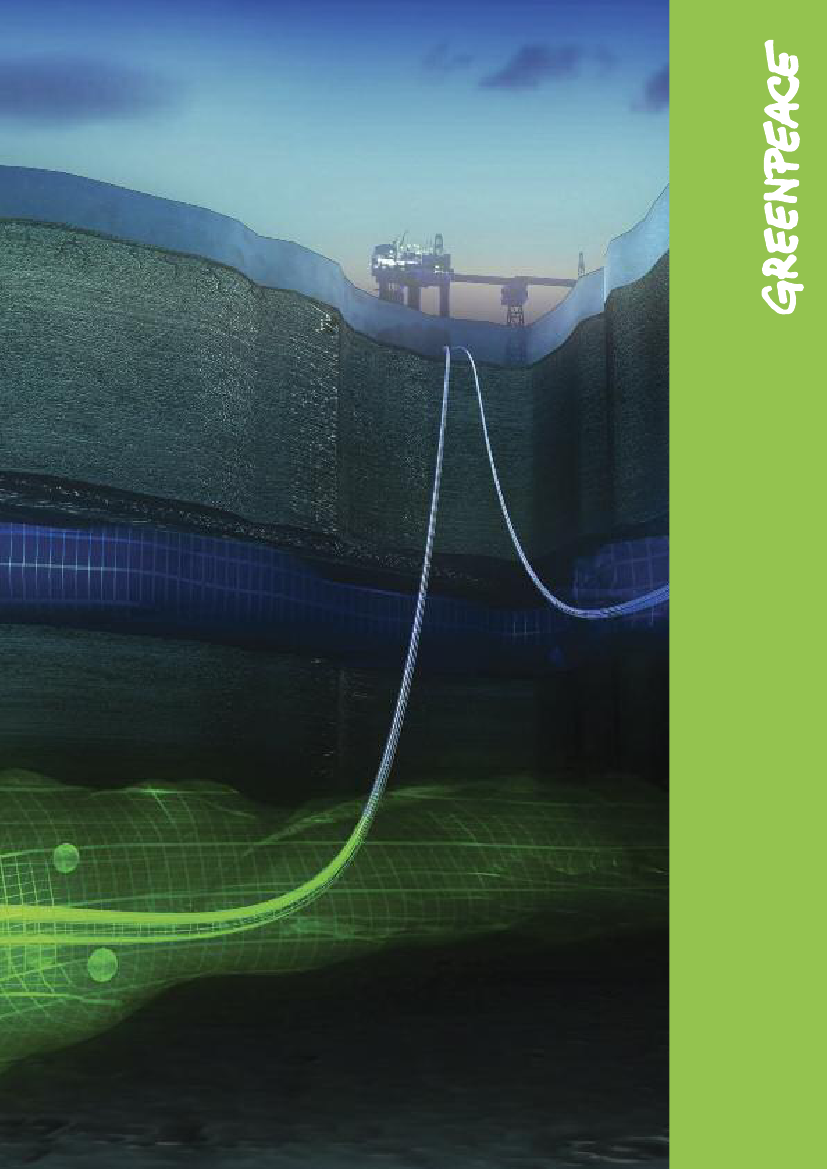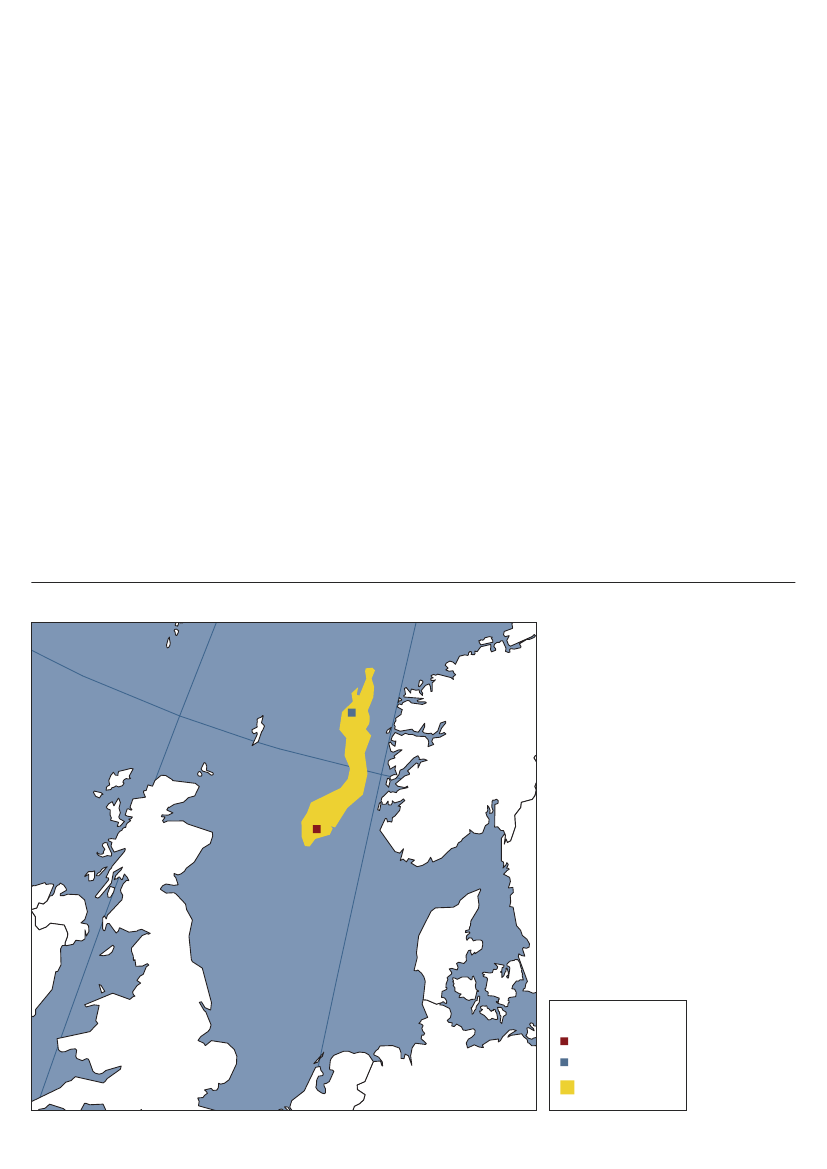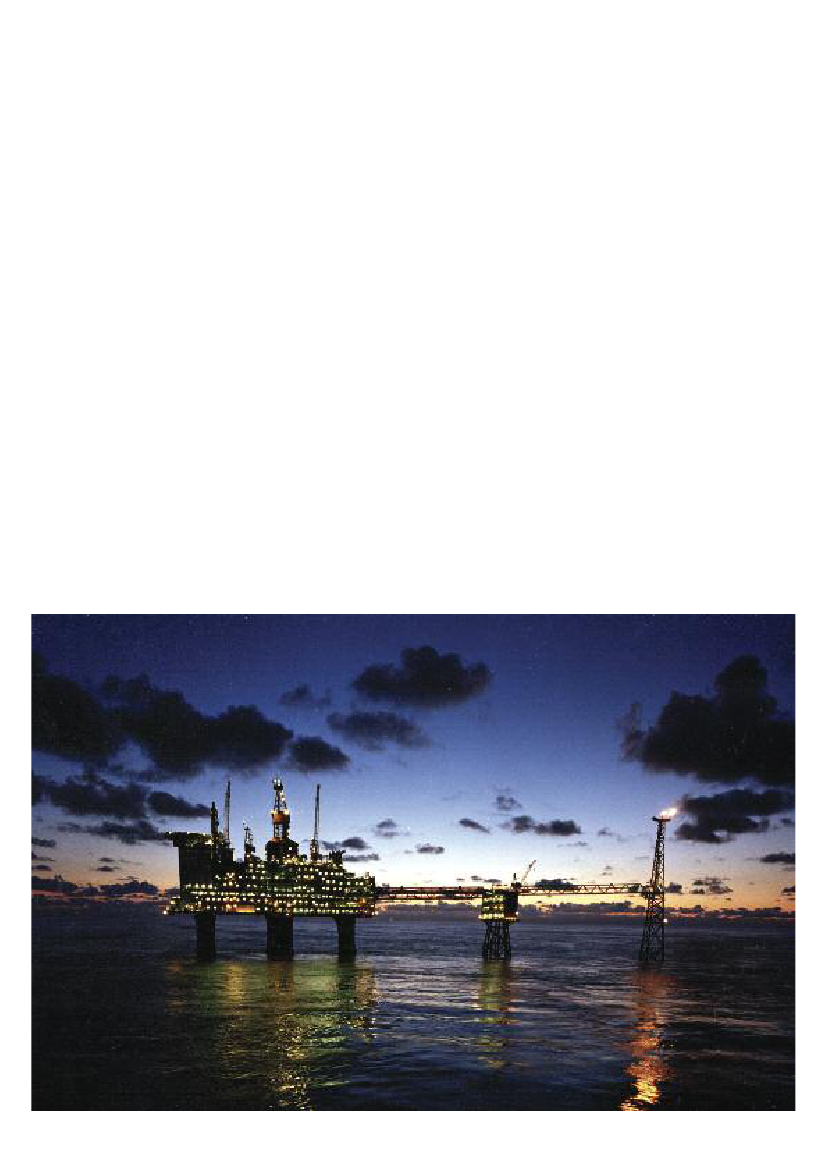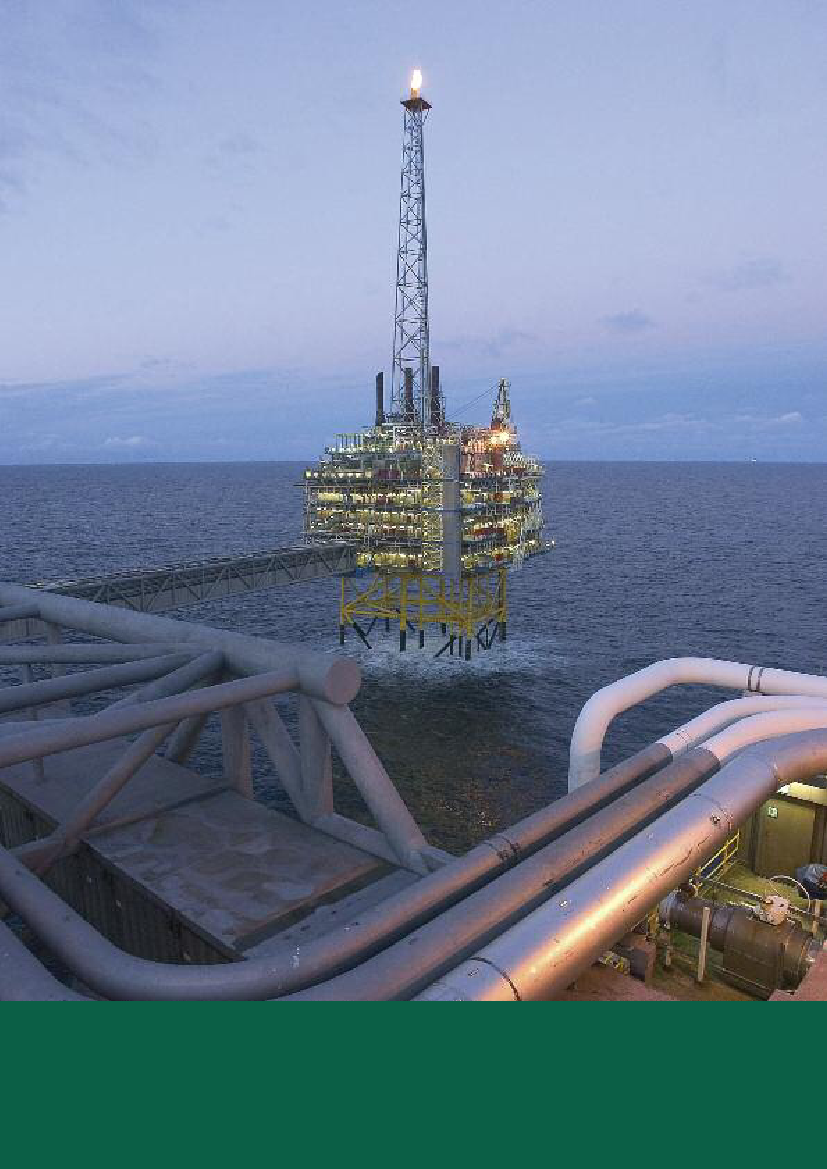Det Energipolitiske Udvalg 2010-11 (1. samling)
L 141 Bilag 4
Offentligt
Reality checkon carbonstorageReport 2009
Recent developments in the Sleipner projectand Utsira formation
Catalysing an energy revolution
Reality check on carbon storageRecent developments in the Sleipner project and Utsira formation
IntroductionClimate change is the greatest environmental threat and humanitarian and economicchallenge the world has ever faced. Millions of people are already feeling the impactsof climate change and an estimated 150,000 people die each year from its effects.1To avoid the worst impacts of climate change, including widespread drought, floodingand massive population displacement caused by rising sea levels, temperature increasesmust peak as much below 2�C (compared to pre-industrial levels) as possible. To do this,the Intergovernmental Panel on Climate Change (IPCC), in its Fourth Assessment Report,indicates that global greenhouse gas emissions must peak at the latest by 2015.Carbon capture and storage (CCS) has emerged as a potential solution to the climate crisis.However, a wide range of issues regarding the safety, efficacy and permanency of CO2storage remain unresolved. By examining the world’s longest running CO2storage project -the Sleipner project, and the Utsira formation on which it is located - this briefing highlightssome of the major challenges and uncertainties facing CCS.Sleipner has been heralded by the European Union, International Energy Agency, and numerousothers as proof that CO2can be safely and permanently stored. However, what this briefingshows is that it may not be possible to accurately map and interpret geological structuresfor the purpose of ensuring safe, permanent CO2storage. Furthermore, Utsira formation storageestimates, which the Sleipner field is a part of, have recently been revised downwards andnon-CO2leakages have also occurred in some projects. In these instances, this briefing revealshow storage estimates, monitoring efforts and technology choices were improperly madeand how geological understanding and expertise were either insufficient or absent.All of this should give pause to governments as they assess their response to climate change.CCS remains largely unproven and will not be ready before 2020 – the key timeframe in whichglobal greenhouse gas emissions must peak then begin to fall. In the meantime, the urgencyto respond to climate change in an effective manner grows with every passing day.
Published by:Greenpeace International.Date:May 2009.Authors:Erika Bjureby, Emily Rochon, Truls Gulowsen.Editor:SteveErwoodAcknowledgements:Haroen Lemmers, Karen Guy, Joris Thijssen.Design and layout:www.onehemisphere.se, Sweden.Printer:www.primaveraquint.nl, The Netherlands.Cover image:� Alligator film/BUG/StatoilHydro. All images � StatoilHydro, fromhttp://fotoweb.statoilhydro.com/fotowebReport available at:www.greenpeace.org/international/Printed on 100% recycled post-consumer waste with vegetable based inks.Greenpeace reference JN244
Published by Greenpeace InternationalOttho Heldringstraat 5, 1066 AZ Amsterdam, The Netherlandsgreenpeace.org
Reality check on carbon storageRecent developments in the Sleipner project and Utsira formationThe Sleipner CO2Injection ProjectThe Sleipner CO2project in the North Sea is one of only four large-scale CO2storage projects worldwide. The project is run byStatoilHydro, which operates the Sleipner field on behalf of a group ofindustrial partners, producing natural gas for a range of customers.2The introduction of a Norwegian CO2offshore tax promptedStatoilHydro to begin stripping CO2from natural gas streams in 1990,allowing the company to save money, and simultaneously conductresearch into CO2storage. To date, these activities have pumpedmore than 11 million tonnes of CO2into the Utsira formation.3According to StatoilHydro, the Utsira reservoir is continuouslymonitored using seismology, and comprehensive models have beendeveloped for calculating how the CO2moves once underground.4The company maintains that there have been no major CO2leaksfrom the Sleipner project.Yet several scientists correctly point out that it is not possible to bethis definitive. Peter Haugan, the leader of the Institute of Geophysicsat the University of Bergen, stated that:“It's not possible to prove thatall injected CO2is still there. There's no way of measuring the amountof CO2in the formation with sufficient accuracy using seismicmapping.”5While StatoilHydro acknowledges this, it neverthelessargues that the above ceiling structures are safe enough to preventleakage into the external environment and there is, therefore, no justcause for concern.6Unpredicted movements of CO2in the formation, however, show thatperhaps thereiscause for concern. When the Sleipner projectcommenced in 1996, CO2was expected to rise gradually through thelayers of the formation once it was injected underground. However,seismic imaging has shown that the CO2is instead flowing almostimmediately to the top of the formation - moving up by more than100 metres per year.7So far, this unpredicted movement has not beensatisfactorily explained by any reservoir geologist. What it does indicateis that the mudstones (rocks) present in the Utsira formation may notserve as the barrier to the vertical CO2movement as originallyexpected. Additionally, it might also mean that the geologicalcharacteristics of the formation have been altered by the injected CO2.8The above demonstrates that currently it may not be possible toaccurately map and interpret geological structures, like the Utsiraformation, for the purpose of ensuring safe CO2storage.9This point isvitally important as avoiding leaks, which could undermine potentialclimactic benefits of geological storage,10depend on the ability topredict how and where CO2will be stored in a formation over thelifetime of a project.11Recent scientific findings further underscore theneed for sites to be secure and potentially monitored for longerperiods of time since much of the CO2will not be permanentlytrapped.12But, regardless of site security, no project can guaranteepermanent storage. Even though unidentified leakages may be unlikelyto occur in well-characterised, managed and monitored sites,13permanent storage cannot be guaranteed since tectonic activity andnatural leakage over long timeframes are impossible to predict.14
Greenpeace InternationalReality check on carbon storage
� Dag MyrestranD/statoilHyDro
3
Reality check on carbon storageRecent developments in the Sleipner project and Utsira formation- continuedGeological storage estimates and the Utsira formationGlobal assessments of CO2storage capacity indicate that salineaquifers15, such as at Utsira, are the formations with the greateststorage potential.16However, most storage estimates are overlyoptimistic and frequently based on methodologies that areinsufficiently robust.17It is important to realise that the CO2storage estimates cited in theliterature are at times purely indicative. As noted by Ansolabehere etal. (2007),“most efforts to quantify capacity either regionally orglobally are based on vastly simplifying assumptions about the overallrock volume in a sedimentary basin or set of basins…they lackinformation about local injectivity, total pore volumes at a given depth,concentration of resources, risk elements, or economiccharacteristics.’’18For example, the vast majority of these estimatesquantify storage capacity assuming that 100% of pore space isavailable to store CO2, when in fact that is never the case.19Storage estimates for the Utsira formation are illustrative of the above.For years, it has been heralded as a geological structure that canstore endless amounts of CO2.20Indeed, the storage potential forCO2in the Utsira formation has been characterised as“practicallyunlimited”21, and“capable of storing up to 600Gt of CO2, e.g. all CO2emissions from all power stations in Europe for the next 600 years”.22Others have described the Utsira formation as“one of the mostpromising aquifers for CO2storage in Europe”.23However, a recent study conducted for the Norwegian PetroleumDirectorate concluded that“it remains uncertain whether Utsira issuitable for large-scale storage of Europe’s carbon emissions”.24Theprimary reason for this is the depth of the formation, which is tooshallow to provide the pressure required to ensure that theCO2staysin a fluid phase. As a result, the Directorate has downgraded thestorage capacity for Utsira from“able to store all European emissionsfor hundreds of years” to “not very suitable”.It is currently unclearhow this revision will impact the effort by Norway to encourage thetransport and storage ofCO2from other countries into the North Sea.
Figure 1.1Location of the Sleipner project and Utsira formation
NORWAY
SWEDEN
DENMARK
LegendSleipner projectUNITED KINGDOMGERMANYNETHERLANDS
TordisUtsira formation
4
Greenpeace InternationalReality check on carbon storage
The Tordis incidentThe difficulty of injecting and storing anything in undergroundreservoirs is illustrated by the Tordis incident. The brief treatment hereof this case provides some key lessons for those contemplating CCSas a solution to climate change.On 14 May 2008, produced water originating from the Tordis field wasbeing injected into the Utsira formation by StatoilHydro in order toincrease gas recovery. Workers on the Gullfaks platform noticed oilywater at the sea surface near their platform. On 30 May, the source ofthe oily water was found to be a leaking crater on the seabed floor.Injection was shut down shortly thereafter and the leak eventuallystopped. The exact amount of the leaked material is unknown;however, the company estimates that anywhere between 48 and175 m3of oil escaped the storage formation.25Even though the Norwegian Petroleum Directorate requires monitoringand warning systems to discover leakages such as these, there wasno system near the location of the leakage, 300 m away from theinstallation and the monitoring system. As a result, an indication thatsomething was wrong happened only after oily water was observed atthe sea surface. It is not certain when the leak first began.26The cause of the leak was later determined to be due to an over-pressurisation of the geological formation. This caused the propagationof fractures to the seabed and the release of oily water into the sea27However, inadequate site characterisation, poor project managementand incomplete monitoring were ultimately to blame.28Statoil’s owninternal investigation showed that assumptions made about theinjection capacity of Tordis were incorrect and the company neglectedto include any geologists on its project team. As a result, the injection
process was based on insufficient geological understanding and weakmodelling analyses.29Further, there were no specific requirements forgeological competence in such projects; possible consequences ofjointing to the ocean floor were not adequately assessed; andequipment for inspection and detection of emissions to the ocean floorwas incomplete and only partially accessible.30CCS proponents have claimed that this is an isolated incident.31Nevertheless, other injection projects in the Utsira formation have hadsimilar problems.32In addition to the Tordis leakage, there have beenat least two other leakage accidents since 2004 - one at theExxonMobil operated Ringhorne site and another at the StatoilHydrooperated Visund site.33While the Tordis and Sleipner fields are located in the Utsira formation,it is important to note that this briefing is not suggesting that leakages inone part of the Utsira formation mean that leakages will inevitably occurin other parts. Sleipner and Tordis are located 300 km away from eachother, and geological maps confirm that while Sleipner is located in avery thick and central part of Utsira, Tordis (and other places whereleakage from oil-water injection has occurred) are located in far thinnerand more marginal locations of the Utsira structure.What the Tordis incident does illustrate are the consequence of makinginvalid assumptions and operating a site without proper monitoring.For example, the project utilised an injection method that createdcracks in the reservoir in order to increase permeability. However, thetechnology used to monitor the site could not differentiate betweenintended and unintended cracks.34This case also proves how difficultit is to inject and store anything in underground reservoirs, even in theUtsira formation, which is considered to be one of the best studiedgeological formations on Earth.
Greenpeace InternationalReality check on carbon storage
� FMC Kongsberg/statoilHyDro
5
Reality check on carbon storageRecent developments in the Sleipner project and Utsira formation- continuedConclusionCommercial viability notwithstanding, the challenges facing CCS aremany. The occurrences described above show that undergroundstorage operations are not simple processes, nor do they offer aone-size-fits-all solution to climate change. The Utsira events regardingleakages, unpredicted CO2movements inside the geological formationand dramatically-reduced storage estimates, underscore how eachfield, each injection rate and each storage location is unique andrequires detailed characterisation, management and monitoring.All too often key points such as these are glossed over in thepublic policy arenas contemplating CCS. Decision-makerswould do well to keep them in mind as they deliberate what role,if any, CCS should play in mitigating climate change emissions.Together with the German Aerospace laboratories, the EuropeanRenewables association and a dozen scientists from around theglobe, Greenpeace produced the Energy [R]evolution. The scenarioshows how CO2pollution can be reduced sharply through the use ofrenewables and energy efficiency to power our society.Scenario available at:www.energyblueprint.info
6
Greenpeace InternationalReality check on carbon storage
� ØyvinD Hagen/statoilHyDro
1Patz, J., et al., 2005. “Impact of regional climate change on human health.” Nature 438: 310-317.2Licensees for the Sleipner West field are Statoil (operator) with 49.50% (this includes 32.37% as thegovernment's direct financial interest), Esso Norge with 32.24%, Norsk Hydro with 8.85%,TotalFinaElf Exploration Norge with 9.41%. See:www.co2captureandstorage.info/project_specific.php?project_id=263See StatoilHydro’s description at: www.statoilhydro.com/en/TechnologyInnovation/NewEnergy/Co2Management/Pages/SleipnerVest.aspx4www.statoilhydro.com/en/TechnologyInnovation/NewEnergy/Co2Management/Pages/SleipnerVest.aspx5Stavanger Aftenblad. 2008, “No guarantee against CO2leakage” 22 October 2008,http://www.aftenbladet.no/energi/olje/933702/Ingen_garanti_mot_CO2-lekkasjer.html6StatoilHydro.2009, “Meeting with Greenpeace”, Internal Memo. 23 February 2009.7Stavanger Aftenblad. 2008, “No guarantee against CO2leakage” 22 October 2008,http://www.aftenbladet.no/energi/olje/933702/Ingen_garanti_mot_CO2-lekkasjer.html8Hermanrud, C, Zweigel, P, Eiken, O, Lippard, J and Andresen, T. “CO2Flow in the Utsira Formation:Inferences Made from 4D Seismic Analyses of the Sleipner Area,”http://aapg.confex.com/aapg/2007int/techprogram/A113135.htm9Bickle, M et al. 2007, “Modeling carbon dioxide accumulation at Sleipner: Implications forunderground carbon storage”, Earth and Planetary Science Letters 255, p.p. 164–176; Haugan, P. M.2008, :Efffects of CO2capture and storage on ocean acidification,” Geophysical Institute, University ofBergen, Bergen Marine Research Cluster in Monaco, October 2008.10Haugan, P. M., Joos, F 2004, “Metrics to assess the mitigation of global warming by carbon captureand storage in the ocean and in geological reservoirs”, Geophysical research Letters, Vol. 31,L18202, doi:10.1029/2004GL020295.11Bradshaw, J. Boreham, C and La Pedalina, F 2004, “Storage retention time of CO2in sedimentarybasins; examples from petroleum systems”., in Rubin, E, Keith, D and Gilboy C Proceedings of 7thInternational Conference Greenhouse Gas Control (GHGT-7) (eds) Vol. 4, p.p. 541-550, 5-9September 2004, Vancouver.12Gilfillan, S.M.V, Sherwood Lollar, B, Holland, G, Blagburn, G, Stevens, S, Schoell, M, Cassidy, M,Ding, Zhou, Z, Lacrampe-Couloume, G and Ballentine, C.J V.2009, “Solubility trapping in formationwater as dominant CO2sink in natural gas fields”, Nature 458, p.p. 614–618. 2 April 2009.13Abanades, J. et al. 2005, “Summary for Policymakers in IPCC Special Report on Carbon DioxideCapture and Storage”, B. Metz et al., Editors. 2005, Cambridge University Press: Cambridge, UK.14Jacobson, M. 2008, “Review of solution to global warming, air pollution, an energy security”, Energy& Environmental Science 2, p.p. 148-173, 2009.15Saline formations are sedimentary rocks saturated with formation waters with dissolved salts.16See for example: www.ieagreen.org.uk/putcback.pdfThe IPCC special report on CCS estimates the total global technical storage potential at 2000 GtCO2in geological formations. http://arch.rivm.nl/env/int/ipcc/pages_media/SRCCS-final/SRCCS_SummaryforPolicymakers.pdf17Anderson, J., de Coninck, H., Curnow, P., Flach, T., Groenenberg, H., Norton, C., Reiner, D.,Shackley, S., Upham, P., Eldevik, F., Sigurthorsson, G., 2007, The ACCSEPT project: multidisciplinaryanalysis and gap-filling strategies, Det Norske Veritas AS.18Ansolabehere, S., Beer, S., Deutch, J., Ellerman, D., Friedmann, J., Herzog, H., Jacoby, H., Joskow,P., McRae, G., Lester, R., Moniz, E., Steinfeld, E., Katzer, J., 2007, The Future of Coal: Options for aCarbon-Constrained World, p.p 45, Massachusetts Institute of Technology.19Bradshaw, J. et al. 2007, “CO2storage capacity estimation: Issues and development of standards”,International Journal of Greenhouse Gas Control 1, p.p. 62-68, 2007.
20See for example, Solomon, S. 2006, “Carbon Dioxide Storage: Geological Security and EnvironmentalIssues – Case Study on the Sleipner Gas Field in Norway”, www.bellona.no/artikler/notat_solomon;Gale, J and Tore, A.T, 2004. “Demonstrating storage of CO2in geological reservoirs: The Sleipner andSACS projects”, Energy Volume 29, Issues 9-10, p.p. 1361-1369; Schrag, D.P. 2007, “PreparingCarbon Capture”, Science 315, 812-813; IEA. 2005. “Latest Seismic results from Sleipner”,Greenhouse Issues, No 76, January 2005.21www.statoilhydro.com/no/EnvironmentSociety/Environment/impactassessments/RegionalEIA/Downloads/RKU%20HaltenbankenNorskehavet%20Juni%201998.pdf (Norwegian)22See, European Technology Platform ZEP 2006, www.zero-emissionplatform.eu, orwww.risoe.dk/rispubl/reports/ris-r-1608_307-313.pdf23CO2point sources and subsurface storage capacities for CO2in aquifers in Norway,www.ngu.no/FileArchive/101/2002_010_skjerm.pdf24www.npd.no/English/Aktuelt/Nyheter/2007.10.29+Store+muligheter+for+lagring+av+CO2.htm25StatoilHydro. 2008. “Corporate Audit. Discharge of oil-containing water and los of injection well.” EPNOWE SNO/ Tordis, 11 August 2008 (Available in full from Greenpeace)26StatoilHydro. 2008. “Corporate Audit. Discharge of oil-containing water and los of injection well.” EPNOWE SNO/ Tordis, Internal investigation of the Tordis event 11 August 2008 (Available in full fromGreenpeace)27StatoilHydro. 2008. “Corporate Audit. Discharge of oil-containing water and los of injection well.” EPNOWE SNO/ Tordis, Internal investigation of the Tordis event 11 August 2008 (Available in full fromGreenpeace)28StatoilHydro. 2008, “Corporate Audit. Discharge of oil-containing water and los of injection well,” EPNOWE SNO/ Tordis. (Available in full from Greenpeace)29StatoilHydro.2009, “Meeting with Greenpeace”, Internal Memo. 23 February 200930StatoilHydro. 2008. Corporate Audit. Discharge of oil-containing water and los of injection well. EPNOWE SNO/ Tordis, 11 August 2008 (Available in full from Greenpeace)31STRACO2. 2009. EU Regulation on CCS. Workshop in Brussels, 24 April 2009.32Today, 20-30 projects are in operation involving injection into the formation.33ExxonMobil. 2004, Årsrapport SFT 2004, Annual report, Balder og Ringhorne.doc /ISk/28/02/05,www.olf.no/getfile.php/zKonvertert/www.olf.no/Milj%C3%B8rapporter/Dokumenter/Balder%202004.pdf (Norwegian only); StatoilHydro. 2008. “Corporate Audit. Discharge of oil-containing water and los of injection well.” EPN OWE SNO/ Tordis, Internal investigation of the Tordisevent 11 August 2008 (Available in full from Greenpeace)34The company employed various methods to monitor the CO2in the Sleipner formation, such asseismic monitoring (use of fixed measuring tools) and pH/CO2buoyancy, see page measurements,and sidescan sonar, seabed monitoring for pockets and brines of CO2.
Greenpeace InternationalReality check on carbon storage
� Dag-tore anFinsen/statoilHyDro
7
GreenpeaceGreenpeace is an independent global campaigning organisation that acts to change attitudesand behaviour, to protect and conserve the environment and to promote peace.Published by Greenpeace International,Ottho Heldringstraat 5, 1066 AZ Amsterdam, The NetherlandsFor more information contact:[email protected]Greenpeace InternationalNuclear Power - No solution to climate change
8
�DAG MyRESTRAND/STATOILHyDRO








